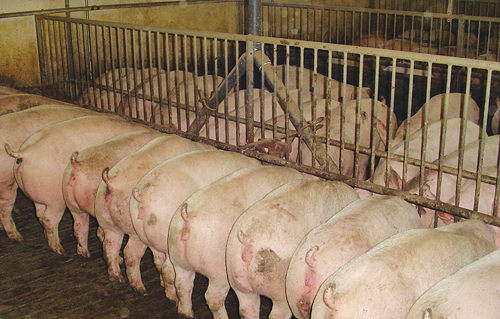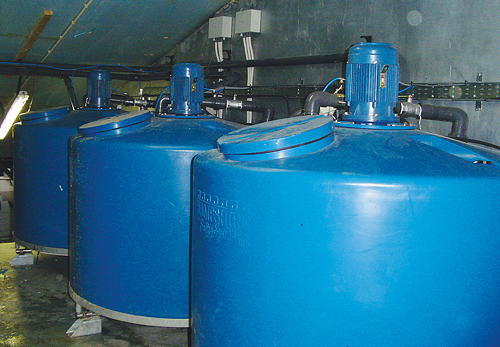In the final part of his three-part series on liquid feeding, Steve Stokes of Hampshire Feeding Systems (HFS) looks at strategies for feeding different classes of pigs
In my previous two articles, I not only looked at the many advantages liquid feeding offers, but also explained the two basic methods of how the feed is delivered to the pigs: restrict and ad-lib – similar to our sit-down meals (breakfast, lunch and dinner) or small buffets respectively.
Although both methods offer the two main essentials required for optimising performance, by controlling and maximising intakes as required, different stock types do respond differently with the two methods. This is because restrict feeding feeds all the pigs in a pen a set amount at certain times of the day and results in very little competition at feeding.

If Ad-lib, meanwhile, creates a stimulus by feeding little and often, creating a fair degree of competition at the trough, but by feeding over a greater period of time, more feed can be consumed. Therefore, with stock where maximising intakes is desired, ad-lib is the preferred method.
Breeding stock
As breeding boars need tight control of their intakes, restrict feeding is the best way to feed them; generally feeding once or twice each day. As they are penned individually, the amount of feed can be dispensed very accurately, and as liquid feed is bulkier than dry (four parts water to one of dry feed), the boars will have their appetites satisfied and be far more content.
Sows in the service and gestation areas are also fed with the restrict method. When penned and feeding into long troughs, they are grouped together to match their intake requirements with group sizes of anything up to 50-plus, with feeding taking place from once up to four times each day.
Liquid feeding is a good fit with electronic sow feeders (ESF) as the sows can consume their feed fast and it is easy to accurately control the amount of feed for each sow. As with the boars, the bulkier liquid feed gives the sows that all-important satisfied feeling that has a huge benefit on their behaviour to each other.
Farrowing sows need the best of both worlds, tight control on intakes in the early stages, but as the milk starts to flow, maximising intakes is essential. This is a perfect situation for ad-lib, dispensing small amounts accurately for each sow means that adhering to a feed curve at the start is easy. As their intake requirements increase, the little-and-often dispensing creates a stimulus that prompts the sow to eat, and coupled with the high palatably and the easy-to-eat nature of liquid feed, takes their intake levels sky high as desired. The HFS ad-lib feeding method of dispensing on pig demand means the sow’s voluntary intake is continuously being recorded, providing management information few other feeding methods can match.
Growing stock
At weaning we traditionally present the piglets with dry feed that’s a totally alien concept compared to mum’s liquid feed they had previously experienced, which produces yet another stress for the piglets at this fragile stage. Liquid feed not only provides the piglet with what they can relate to, but also something that they will like.
Although automated liquid feeding in the very early stages is not always a plug-and-play concept due to the risk of feed spoilage, it works perfectly well for piglets from about 10kg and more. Maximising intakes in these early stages is key to optimising performance throughout the pig’s life, and the little-and-often delivery method lends itself to feeding weaners perfectly.
Liquid feeds are highly palatable and easy to eat, and they work really well for weaners that, unlike most other stock, tend to be a little fussy about what they eat. The system can be used in pen sizes ranging from quite small to those that hold hundreds. As with all HFS’ ad-lib systems, we have a recommended maximum trough length so the feed has a chance to flow to the trough’s extremities in a reasonable amount of time (seconds), and this governs the maximum number of pigs that can be fed from a single trough.
Clearly weaners demand less trough feeding space than larger growing stock and the number of pigs that can be fed from the largest double-sided trough that we would recommend will fall from 200 to 180 as they grow. It’s important that the correct number and length of troughs is used based on the number of pigs in a pen.
Growers still benefit from the little-and-often ad-lib feeding method to maximise intakes. Maintaining high intakes throughout this stage is essential to continue growth inertia that goes a long way to reducing those all too important days to slaughter. Unlike weaners, these pigs are not so fussy about what they eat, and also not so timid with each other at feeding – therefore trough divisions no longer need to blinker eye contact between them and a more open trough design can be used that will take them right through to slaughter weight.
Finishers, depending on genetics and marketing contracts, can require feed intakes to be controlled in the latter stages to maintain carcase quality – therefore both ad-lib and restrict feeding can be used. Ad-lib has the advantage of being able to maximise intakes when required; has no constraint on pen size/shape; can, of course, control intakes; and when feeding on pig-demand, it will record the pigs’ voluntary intakes.
Restrict feeding demands a fair degree of tweaking to maximise intakes to satisfy appetite, but by offering the pig very little competition at the trough during feeding, it lends itself to controlling intakes. Also, as the whole pen of pigs is fed together, shoulder-to-shoulder at the trough, it provides a useful visual check on the pigs.
I hope this series has given you a better understanding of what liquid feeding entails and has illustrated that all farm sizes and stock can benefit from this system.
For more information visit: www.hampshirefeedingsystems.com
Part one of this series can be found by CLICKING HERE
Part two of this series can be found by CLICKING HERE




